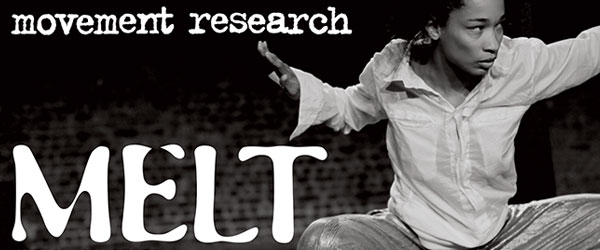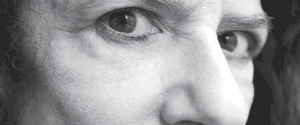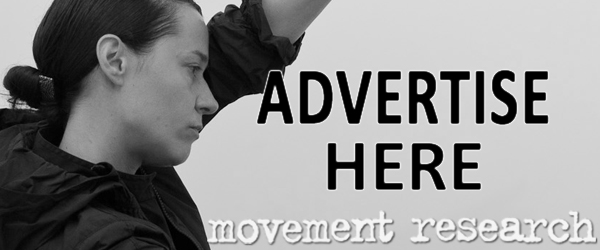Critical Correspondence
- 2 kilos, Baryshnikov Arts Center
- Comments Off on Deganit Shemy in conversation with Stephanie Miracle
- Conversations
- 9.14.11
Deganit Shemy in conversation with Stephanie Miracle
Stephanie Miracle (Washington D.C.) and Deganit Shemy (Israel/NYC) discuss Shemy’s working process for 2 kilos of sea, which will be presented at the Baryshnikov Arts Center, September 15-17. Miracle, a former dancer of Shemy’s, remembers that “There was a sense that the work already existed and we just needed to encounter it.”
Thumbnail photo: Yi-Chun Wu.
Interview date: September 3, 2011
Download the PDF version of this document
Stephanie Miracle: So you are working on 2 kilos of sea, which was part of LMCC [Lower Manhattan Cultural Council]’s Sitelines Festival in 2010, right?
Deganit: Exactly. You saw that?
Stephanie: Yes, I saw it! It was one of my favorite works. That piece was for the churchyard and it really used the space—all the different narrow crannies, the sculpture and the walls. How are you doing that at Baryshnikov Arts Center now?
Deganit: That’s a good question. When Misha [Mikhail Baryshnikov] saw it he talked about creating a set that would imagine the same kind of relationships to the space that you saw—the corners and stuff like that. He had some suggestions to make me really think. The set created such an inner story and a feeling of a holy place. I didn’t feel like I needed to do a lot. And then I said, “Wait a minute. Maybe I need to try it without a set at all, and see if it’s strong, and if there is something there—the essence.” And, we did it at APAP [Association of Performing Arts Presenters]—I think you were there? I wasn’t happy at all.
Stephanie: Yeah, when I met you I saw that you also thought “it was not good.”
[laughter]
Deganit: Yeah, I was criticizing it myself as well. You know, though I really love the cast and it was a really amazing process, I always criticize the piece and I thought, “It’s not that.” And, then I gathered with Lenore Doxsee, she’s our stage designer. She’s amazing. She built everything and she’s the lighting designer. We wanted to somehow keep the meaning but try to be the same. We didn’t want to try to duplicate the space or the stage. Sometimes you see stage design try to be some specific place.
Stephanie: When I saw it [2 kilos of sea] in the church there were two men and four women. But, now, it’s just one man.
Deganit: Yeah. I am very sad because Nick [Nicholas Bruder, the other male dancer] was amazing, amazing, amazing to work with, but he’s involved with another project. It would have been too much for him. I am sad, but, somehow, it made me change more. It made me not try to repeat the same thing.
Stephanie: Can you talk about the male-female relationships, because so much of your work was only female for a long time, and this really has strong male-female relationships.
Deganit: Yeah, it’s very easy to go there the moment you put men in the work, there is always a relationship between genders. It’s always there. I think this specific piece is using stereotypes that I have about men and also trying to open them or break them and really reach farther than them. I love to use stereotypes because I think it amuses me, especially in dance. I don’t want to tell stories. I try to use these stereotypes, or archetypes, just to see what’s come to me. Then I can erase them. I am not using lots of theatrical gestures. The dance itself is trying to be something in between so that it’s the movement that says something. The movement creates the feeling. I changed a lot because I am giving more freedom to people to just live inside and to let me give them the information and to just see. They could be like, “ugh,” because I had something specific but I want to be very supportive of my dancers and let them be in this area where they can just see themselves inside. They lead me to what they are.
Stephanie: Yeah, I notice that a lot, that the dancers shift back and forth between kind of a mechanical or disconnected, inhuman state. And then, sometimes they make direct eye contact with an audience member or really show their humanness. Which can be very manipulative.
Deganit: It’s true, it’s very manipulative. And, also, now it’s more in between the character and the dancer. This is the difference from before because I was very afraid of storytelling. It scares me. But, I thought why not? Let’s give it a chance. Maybe it will open up something else. I am using very basic structures to present these ideas. It’s very much like directing: seeing what comes from the movement and trying to organize it more, find the right timing and the combination in between the characters. In the past, I was trying to make that character from my fantasy and I gave lots of freedom to create but in very, very, very specific ways. This time, everybody created her own character, but I also directed. I can give more space because I know people are very different. I love to work with people. I am curious about people. So, slowly, slowly I started to open this piece. I think it happens when you are less insecure and you trust your insides.
Stephanie: Right. That begins to empower your dancers as collaborators, too, I assume.
Deganit: Yeah. Then they get stronger and stronger. Sometimes I feel like, “Oh, I am losing it, I am losing it,” because it can take you to a different place. And I think, “No, no, no, no, this is not the story.” It is a tiny balance between leading and letting them go.
Stephanie: Another thing I feel is true for a lot of your work, I don’t know if you think this is true about 2 kilos, but the characters seem to be caught in cycles within a world. There isn’t necessarily a way out of this existence that they are in. So, it’s not a clear narrative or anything like that. There are characters existing within a specific world.
Deganit: Very deep in the world there is something very sonic… something that is supposed to have destiny.
Stephanie: Fate?
Deganit: And we just repeat it. Even if we leave awareness, the character usually has a different kind of awareness. One will be completely blind. They are changing, but there is always a different kind of awareness to the situation.
Stephanie: I started working with you in 2007 on Iodine before it premiered at P.S. 122 in February of 2008. And, that piece, to me, in some ways seemed darker than Arena, which was created for Dance Theater Workshop in 2009 and, now there is 2 kilos, and the content seems to have similar psychological threads. The last two works have more obvious humor or color or character. Definitely, I saw that in the costumes. Can you talk about your evolution from the last couple pieces?
Deganit: I think that what was missing in Iodine for me was the humor [laughs]. It’s like sticking your head again and again in the water. I still somehow laugh at that piece because it was so crazy, I was so obsessive. It was so funny. It was very strong, the need to do something so specific. It’s very hard to understand this craziness. It can be very obsessive. I do really think that it’s great that I went so far with ways of movement, but, later on, I was sick from it. I saw that it can’t go so far. I think there were changes to Iodine. You remember?
Stephanie: Yeah.
Deganit: I felt they were good changes. It was less repeating the same thing. I took out a lot of stuff and cleaned it. I started to be more conceptual. I thought to use something from the vocabulary that is very structure-like and mechanic. Like statues—moving kinetic statues. I though it’d be great to put it in an arena. You know, there is the arena and in it is a sport and it’s very controlled. But under it, all this ease. I like these contradictions. Every piece leads me to ask, maybe there is a different way to look inside or see these things. You know, it’s more conceptual—but it’s also very emotional to me. It’s very hard to separate between concepts and emotions because, the concept that I choose I am very emotional about [laughs].
Stephanie: The works are very deep. It’s not superficial.
Deganit: Sometimes, you ask yourself, when you create, “What leaves you?” And, then, it’s something that you know. It’s something inside that you have from your experience usually. If you trust that it’s there more and more, you let yourself be less afraid and you give more to the people around you to live in the concept. You give the concept, let it develop. I really love that way of working now much more than before.
Stephanie: I remember when we were rehearsing with you during Iodine , we were always looking for, or trying to find, the movement as if it already existed in the world and we were just trying to grab hold of it, instead of thinking of it as something that we could just generate or make up. That was very powerful to experience because you talked about your obsession of wanting to get the work out and there was a sense that the work already existed and we just needed to encounter it.
Deganit: I can’t believe you remember all of that. Stephanie, you were so young, so smart. It’s true. That’s what I thought.
Stephanie: What was also so interesting about that process for me, as a dancer, was that as we began to put ourselves into the movement, it became so etched within my body, I feel like I could do that piece now. It was such a strong, physical memory. The connections were so detailed and intricate.
Deganit: Stephanie, I remember you. I remember I didn’t need to have a piece with six characters, but I wanted to use them. I added you, remember? We didn’t really need you there in the piece. It was just you. You had this character with you and I think that’s what grabbed me. You brought something else. And now I think more and more, this is what I am looking for. For people to just dramatically be in the character and take it. It was a feeling that it existed before somehow. A few people helped me to design it. I took from the others and it always worked.
Stephanie: Can you talk about your history of studying visual art at the Kalisher School of Art in Israel? How that has influenced your choreography?
Deganit: I didn’t come from a regular dance education and I never was a real dancer, like you or most of my dancers. I was really curious about movement and wanted to dance and I was doing gymnastics before, but visual arts opened me up. I suddenly understood that I always wanted to be a dancer. When I was young, I was playing violin and I did gymnastics. Then I had to choose because my parents couldn’t pay for everything. Finally, I chose through a chance operation and I had to quit dance. And, then I started to draw afterwards. I was really into drawing and sculptures and art and I went to a school for art in Tel Aviv, which was a very strong experience. I really loved all of the conceptual art and I loved that you can use an object as something to teach you so far from the form itself. Then I saw Simone Forti’s work and realized, “Okay, maybe I can start to do more styling. It’s not too late for me” [laughs]. You know, I was 26. Maybe, I can start to do more. And do it less like a dancer, but more like a mover.
Then I saw that there is a movement notation in Israel in the academy [Rubin Academy of Music and Dance]. There is a movement department that emphasizes notation. I went to see. It was something so amazing but also very scary. I thought that maybe I wouldn’t be able to put my own touch to it. It was a different way of moving. I think it was a very, very strong tool because it also affected my choreography in working with limitation. My relationship between body and space was from there, because I think very much more body-wise than space-wise. It was just the right way to move after I finished the four years at the Kalisher School of the Arts, to go to movement.
Somehow then I started to dance with a company and do my own stuff, but I was very afraid to get into that. Even at the academy, there was a strong separation between the movement department and the dance department. The dance department was really serious. They danced ballet and modern, everything. And, I was jealous but we [the movement department students] were different and it was very wild. We studied contact improvisation and martial arts. I was so happy to be there. But I always looked at the dancers and thought that I wouldn’t be able to do that. And, when I finished, I started to think, “No, you can create your own stuff. You don’t need to be like them.”
Stephanie: I saw on your website a video for Hungry Kite. Are you working on something new?
Deganit: Yeah, yeah, yeah!
Stephanie: Tell me about that.
Deganit: It’s different. It’s a collaboration with Jim Finley and he’s a figure artist. We started something and I can feel it’s going to change a lot. But, we are going to continue to develop it. We will premiere it in 2012 in New York. I think you mentioned it because it’s more visual art?
Stephanie: Yes.
Deganit: I think because this side is very strong with me, I am trying somehow to come back to it again. We’ll see.
Stephanie: When I saw you in June, I believe, you said that you might be moving back to Israel.
Deganit: Yeah, next month we are moving, my family. But, I am going to keep working with the company here and so I will be moving in between.
Stephanie: So, what are your thoughts on the dance community in Israel? Since you will be there some.
Deganit: Yeah, it has probably changed, so I am curious to see how it’s changed. It was always very physical and emphasized the movement vocabulary and it seemed to be very strong. It can be more emotional, maybe. It’s hard to define. I think that it’s very physical and immediate. Less conceptual, do you see that, also?
Stephanie: I do, I notice that. It’s very physical, visceral, sometimes creates emotions through physicality but, conceptual I haven’t seen as much.
Deganit: No, there is some, but I think here [in the United States], it’s more developed from the 70s. From all the minimalist artists.
Stephanie: Do you think you are interested in doing site-specific work again, in the future? Or do you prefer the theater?
Deganit: I really want to do more site-specific work. And, one of the things that helps me to come back to Israel, because it’s really hard, and still try to keep my company in existence, is that I can really, really connect to the sites in Israel. The ability to move a little bit, a few kilometers, a few miles, and you are in the desert. I finally realized that I want to work more with different sites. I am curious. I am also going to do a site-specific work in Finland in a beautiful building.
Stephanie: When will that be?
Deganit: Beginning of November, the first two weeks.
Stephanie: Great! Well, it’s really, really great to talk with you and it’s always enjoyable to hear about your thoughts.
Deganit: It’s great to talk with you. I am so happy it’s you because I am happy that you know me from my beginning…a long time ago.




